Update: fines were levied. Also note that I originally wrote that they were fighting just one fine, there were two $2,000 fines at issue.
What was Jeffrey Braun, a hard-driving land-use lawyer who represents major developers like Donald Trump and institutions like the Guggenheim Museum, doing Monday at a hearing of the city’s Environmental Control Board (ECB), the administrative tribunal that oversees violations issued by city agencies?
 Well, Braun (right) also represents Forest City Ratner (FCR), and even though the penalty at issue was just $2000—surely less than the cost of getting Braun to Brooklyn—the developer’s challenge concerns perception as much as cash. (Update: there were two $2,000 fines, but still likely less than overall fee.)
Well, Braun (right) also represents Forest City Ratner (FCR), and even though the penalty at issue was just $2000—surely less than the cost of getting Braun to Brooklyn—the developer’s challenge concerns perception as much as cash. (Update: there were two $2,000 fines, but still likely less than overall fee.)
FCR plans to demolish a dozen buildings in the planned Atlantic Yards footprint; meanwhile, the developer seeks to disprove charges that a contractor last June used a backhoe to demolish a wall adjacent to a residential structure, violating safety standards and alarming the tenants. That story, first reported in this blog, was picked up by the New York Times.
In a two-and-a-half-hour hearing, Braun pressed hard, questioning some photos that a city inspector found convincing, contending that a witness was biased, and steadily raising objections.
Had it been a criminal case, he might have planted reasonable doubt. But there's a lesser standard of proof in such administrative cases, "preponderance of the relevant evidence." [See Rules of the City of NY, Title 15, §32-02(b)(2).] And Braun was dealt a tough hand to play, given that he admitted from the start that the contractor committed one of the two violations.
Office = hearing room
Before the hearing was called, the parties waited nearly 90 minutes in the 11th floor waiting room at 233 Schermerhorn Street, a space with stiff plastic seating and photocopied posters on the walls.
Then eight people squeezed into the office of Administrative Law Judge Helaine Balsam, forming a semicircle of two rows each. It was a far cry from the expansive modern federal courtroom in which Braun argued an Atlantic Yards case five weeks earlier.
 The group, besides the judge and Braun, included two representatives of Solomon Oliver Mechanical Contracting, the firm hired for the demolitions; three staffers from the Department of Buildings (DoB); witness David Gochfeld, whose fiancée lives at 624 Pacific Street; and this reporter.
The group, besides the judge and Braun, included two representatives of Solomon Oliver Mechanical Contracting, the firm hired for the demolitions; three staffers from the Department of Buildings (DoB); witness David Gochfeld, whose fiancée lives at 624 Pacific Street; and this reporter.
Braun wore a suit; everyone else dressed in either business casual or construction casual. To create a record, Balsam deployed a cassette tape recorder of some vintage.
At issue were violations for two instances of unsafe demolition, at 622 and 620 Pacific Street (the two buildings at center), because the contractor had not applied for a permit for mechanical demolition but instead used a backhoe to take down walls of each building. Both buildings were deemed unsafe by the Empire State Development Corporation, and thus subject to emergency demolition.
(Photo from December 2005, by Norman Oder; 622 Pacific is the one-story building.)
The case begins
Braun, at first, objected to this reporter's presence, saying I was “not a party to the case.” Balsam informed him the press wasn’t barred.
Then Braun launched into an opening statement, admitting that the contractor had used a backhoe at 620 Pacific, which abutted an empty building, but said that was it. “To the best of our knowledge," he told the judge, "there was no use at 622 Pacific Street,” which abuts the occupied 624 Pacific Street.
 Balsam--also Managing Attorney of the ECB--dryly suggested that Braun should first let the DoB make its case, which charged that a backhoe was used to dislodge bricks from a wall (right) attached to the occupied 624 Pacific Street.
Balsam--also Managing Attorney of the ECB--dryly suggested that Braun should first let the DoB make its case, which charged that a backhoe was used to dislodge bricks from a wall (right) attached to the occupied 624 Pacific Street.
[Update: A reader points to the intact fence in the upper right of the photo. That's absent from the second to last photo near bottom.]
(Photo copyright David Gochfeld)
The violations were written up in September, but the events occurred in June. Hearing representative Chris Oliver (unrelated to Solomon Oliver) then asked Phillip Krikorian, an inspector for the DOB’s Buildings Enforcement Safety Team (B.E.S.T.) to explain how he learned of the violations after the fact.
Braun objected, suggesting that the DoB's Oliver was soliciting hearsay. “Our rules of evidence," Balsam pointed out, "do allow for hearsay.”
Krikorian, in a gravelly voice, explained that a demolition using mechanical equipment requires a pre-inspection before a letter is issued. “On this job, to the best of my knowledge, they never asked for it,” he said.
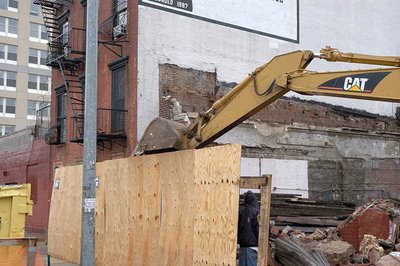 No safety zone
No safety zone
The DoB's Oliver pulled out a stack of photos Gochfeld took. He pointed to one. “The bucket [of the backhoe] is up against the adjoining building that is not being demolished,” Krikorian declared.
“That photo is specifically why you’d have to have a letter for mechanical demolition.”
(Photo copyright David Gochfeld)
Why? Krikorian explained that mechanical demolition requires a safety zone and "that safety zone could’ve never existed.” Braun was tight-lipped. The demolition, Krikorian said, should’ve been done by hand, with machinery available to remove debris and load it into a container.
(Note: Without access to the record, I'm not certain that this was the photo he cited, but more than one photo showed the bucket very close to the wall, as noted below below. )
Braun cross-examined Krikorian, establishing that the inspector hadn’t been to the site when the alleged violations occurred. Rather, the citations were based on Gochfeld’s photos and statement. Krikorian acknowledged that it was the first time he found violations in that way.
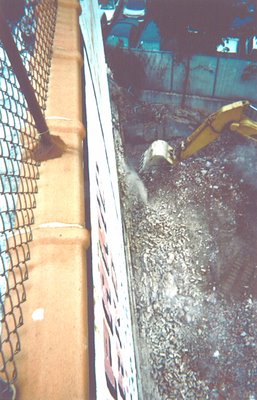 Braun queried him: “The mere presence of heavy equipment is not a violation of the building code."
Braun queried him: “The mere presence of heavy equipment is not a violation of the building code."
Absolutely right,” Krikorian responded. “It’s how you use it.”
Braun pointed to a photo (left) Gochfeld took from his building’s roof, looking down. “You don’t see it demolishing the building,” he said.
(Photo copyright David Gochfeld)
“I do,” Krikorian countered. “I see the bricks coming off the building in mid-air.”
That observation remained a point of contention.
Man with a camera
Chris Oliver called Gochfeld to testify. Gochfeld explained he was staying with his fiancée Leigh Anderson, a building resident. (Anderson's a plaintiff in two current lawsuits involving Atlantic Yards.)
He showed pictures of the backhoe demolishing the wall of 620 Pacific and said that he saw the contractors using the same technique on the 622 Pacific wall abutting Anderson’s building, “but every time I came out, they stopped.”
Gochfeld described the backhoe as centered between the two properties to be demolished, so its bucket could be used on each wall. “We were in fear that our building was going to collapse," he said softly. "It felt like an earthquake—regular, rhythmic pounding.”
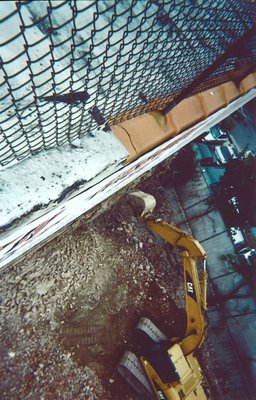 Balsam asked him to speak louder so the tape recorder would pick up his testimony. Gochfeld explained that recalling the event still left him unnerved: “It was actually quite terrifying.”
Balsam asked him to speak louder so the tape recorder would pick up his testimony. Gochfeld explained that recalling the event still left him unnerved: “It was actually quite terrifying.”
After Braun began cross-examination, Gochfeld explained that he called 311 and also the police in response to the demolition. Braun asked if the DoB issued any violations. Gochfeld said there were violations, but not regarding the mechanical demolitions.
Braun asked if Gochfeld could identify Butch Banks, the foreman on the project, who was sitting a few seats away. He could. Braun then asked, “Did you tell him you hated Forest City Ratner?”
Gochfeld denied using the word “hate” but said he’d expressed his dislike of the company and its plans for the Atlantic Yards project. Banks, he said, told him, “Oh, you’re the one we’ve been warned about.”
Gochfeld said he assumed Banks was referring to Daniel Goldstein—another bespectacled 30something with the same initials—the spokesman for Develop Don’t Destroy Brooklyn who lives just two buildings away.
(Photo copyright David Gochfeld)
No scaffolding
Braun called Solomon Oliver, a 60ish man with a Caribbean lilt to his voice, as a witness. Solomon Oliver said that he did not give instructions for mechanical equipment to be used for demolition and that wrecking bars and sledgehammers should be used. (The choice of Solomon Oliver, a minority-owned firm, was recently praised by a signatory of the Community Benefits Agreement.)
The contractor recalled encountering Gochfeld, who told him he didn’t want the developer to take down buildings in the footprint. On his daily visits, Solomon Oliver said, he observed only proper demolition techniques.
Under cross-examination from the DoB's Oliver, a 30something man with a faint Caribbean accent, Solomon Oliver acknowledged there was no scaffolding used for the demolition--and it wasn’t required, because "it was a one-story structure," he said.
Judge Balsam asked for clarification; were both one-story buildings?
Both, said Solomon Oliver.
The DoB's Oliver countered, "Our information is it's a two-story building."
Foreman Banks, a burly fellow in a leather jacket, took the stand, citing nearly 30 years of demolition experience. “For the record, one was a two-story, the other was a one-story,” he said, correcting his boss.
Braun walked him through the demolition process. Did DoB, he asked, issue any violations based on mechanical demolition? No, Banks responded.
Banks, referring to Gochfeld as “Goldberg,” said that the latter had apologized for calling the cops, but had said he felt his building was in danger. (Chris Oliver, apparently new to the case, also got Gochfeld’s name wrong.)
Braun pointed to one photo of the backhoe and asked Banks what it indicated. “We’re lifting debris right here,” Banks declared. Krikorian, the city inspector, wasn't testifying for the record, but could be heard to mutter incredulously, “The bucket’s upside down.”
Two versions of the facts
Braun asked Banks plainly if the backhoe’s bucket was used to demolish the wall at 622 Pacific. “Nah, I’m positive,” Banks replied, a bit subdued. “You can’t take a chance swinging a bucket like that. It’s too close to 624.”
“Mr. Gochfeld’s not correct?” Braun continued.
“Yes, he’s not correct,” Banks responded.
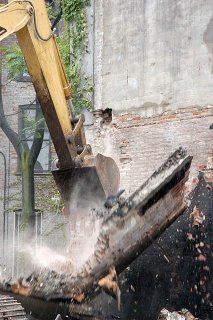 Then Braun had to address the actual violation. He showed Banks the photos Gochfeld took of the mechanical demolition at 620 Pacific. “Why’d you use the bucket?” Braun asked.
Then Braun had to address the actual violation. He showed Banks the photos Gochfeld took of the mechanical demolition at 620 Pacific. “Why’d you use the bucket?” Braun asked.
(Photo copyright David Gochfeld)
“Because this part of the wall was hard to come down,” Banks said, explaining that hand demolition had been uneven and left a hole.
How long did it take? “About ten minutes, seven minutes,” Banks responded. He agreed that he made the decision without consulting his boss.
Unoccupied building?
Though Gochfeld wasn’t asked the question Monday, he last June described a more ominous scenario, in which the workers from Solomon Oliver Mechanical Contracting believed they were working next to two unoccupied buildings "The foreman said to me: 'They told me that nobody lived there,'" Gochfeld said at the time.
That foreman was Banks. On Monday, the DoB's Oliver asked Banks, “Were you informed 624 wasn’t vacant?”
“Nah, it wasn’t vacant,” Banks replied. He didn’t quite answer the question, but the cross–examination didn't go further.
On redirect examination, Braun took the opportunity to question his witness one more time. How then, did the contractor demolish the wall of 622 Pacific that abutted the building where Gochfeld stays?
Banks explained that workers stacked up lumber along the wall and stood on it, using hand tools. (The photo below does suggest stacked lumber, but also shows the bucket touching--or nearly touching--the building. Photo copyright David Gochfeld.)
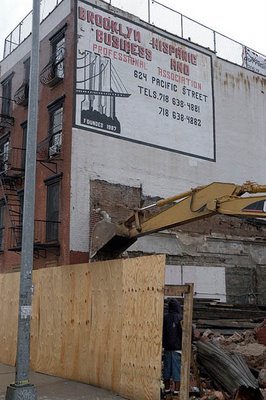
Belated rebuttal
After Braun finished, Judge Balsam asked the DoB's Oliver if he had any rebuttal witnesses. He said no. Krikorian nudged him; he said yes.
Based on your experience, Krikorian was asked by the DoB's Oliver, would a scaffold be needed for such a demolition? Braun objected on grounds of relevance. The judge let the question stand.
“I’ve done demolition inspections since 1988—at no time have I seen a building come down without a scaffold,” Krikorian said emphatically. “A scaffold allows you a buffer zone. I would find that, at the least, a very unsafe way of taking down a wall.”
Braun moved to strike the testimony. Balsam said she wouldn’t, but stopped Krikorian from going on.
Final arguments
 In closing, Braun conceded the violation at 620 Pacific but said that there wasn’t evidence for the other violation. The photos didn’t prove anything, he asserted, and Krikorian wasn’t present.
In closing, Braun conceded the violation at 620 Pacific but said that there wasn’t evidence for the other violation. The photos didn’t prove anything, he asserted, and Krikorian wasn’t present.
“We’ve had testimony from an occupant, but he’s a layperson and, to put it crudely, has an axe to grind,” Braun said, citing Gochfeld’s political opposition to the project and his understandable concern about his building.
[Update: Note the damaged fence behind 624--signs of hand demolition?]
(June 2006 photo by Norman Oder)
“We ask you to consider evidence in mitigation,” Braun continued, noting that Solomon Oliver had directed that hand equipment be used and that Banks decided that holes in the adjoining building meant that “safety required” mechanical demolition. (Braun bypassed the “hard to come down” admission.) He asked for an “appropriate fine” for that violation.
Balsam explained that her discretion was limited—“it’s all or nothing; there’s no mitigation of penalty, which in this case is $2000” per violation.
The DoB's Oliver argued that the violation should be sustained “due to the foreseeable danger and the harm to the adjoining property.”
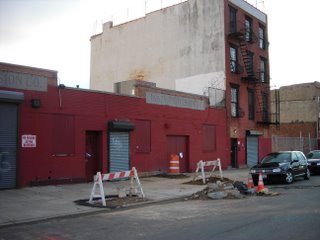 The DoB rep--maybe because he lacks Braun's jugular instinct or because such hearings aren't generally confrontational--chose not to attack the credibility of the defense witnesses, even though Banks had already admitted one violation.
The DoB rep--maybe because he lacks Braun's jugular instinct or because such hearings aren't generally confrontational--chose not to attack the credibility of the defense witnesses, even though Banks had already admitted one violation.
Still, Judge Balsam, who went through three cassette tapes during the hearing and took steady notes, was left with a lengthy record to examine. She said she’d reserve her decision until a later date.
By then, it’s likely that Forest City Ratner will have demolished more buildings, that their contractors will have been reminded not to cut corners, and that residents in the footprint will have their cameras ready. Indeed, one of the buildings slated for demolition (above) abuts the other side of 624 Pacific Street.
(February 2007 photo by Norman Oder)
What was Jeffrey Braun, a hard-driving land-use lawyer who represents major developers like Donald Trump and institutions like the Guggenheim Museum, doing Monday at a hearing of the city’s Environmental Control Board (ECB), the administrative tribunal that oversees violations issued by city agencies?
 Well, Braun (right) also represents Forest City Ratner (FCR), and even though the penalty at issue was just $2000—surely less than the cost of getting Braun to Brooklyn—the developer’s challenge concerns perception as much as cash. (Update: there were two $2,000 fines, but still likely less than overall fee.)
Well, Braun (right) also represents Forest City Ratner (FCR), and even though the penalty at issue was just $2000—surely less than the cost of getting Braun to Brooklyn—the developer’s challenge concerns perception as much as cash. (Update: there were two $2,000 fines, but still likely less than overall fee.)FCR plans to demolish a dozen buildings in the planned Atlantic Yards footprint; meanwhile, the developer seeks to disprove charges that a contractor last June used a backhoe to demolish a wall adjacent to a residential structure, violating safety standards and alarming the tenants. That story, first reported in this blog, was picked up by the New York Times.
In a two-and-a-half-hour hearing, Braun pressed hard, questioning some photos that a city inspector found convincing, contending that a witness was biased, and steadily raising objections.
Had it been a criminal case, he might have planted reasonable doubt. But there's a lesser standard of proof in such administrative cases, "preponderance of the relevant evidence." [See Rules of the City of NY, Title 15, §32-02(b)(2).] And Braun was dealt a tough hand to play, given that he admitted from the start that the contractor committed one of the two violations.
Office = hearing room
Before the hearing was called, the parties waited nearly 90 minutes in the 11th floor waiting room at 233 Schermerhorn Street, a space with stiff plastic seating and photocopied posters on the walls.
Then eight people squeezed into the office of Administrative Law Judge Helaine Balsam, forming a semicircle of two rows each. It was a far cry from the expansive modern federal courtroom in which Braun argued an Atlantic Yards case five weeks earlier.
 The group, besides the judge and Braun, included two representatives of Solomon Oliver Mechanical Contracting, the firm hired for the demolitions; three staffers from the Department of Buildings (DoB); witness David Gochfeld, whose fiancée lives at 624 Pacific Street; and this reporter.
The group, besides the judge and Braun, included two representatives of Solomon Oliver Mechanical Contracting, the firm hired for the demolitions; three staffers from the Department of Buildings (DoB); witness David Gochfeld, whose fiancée lives at 624 Pacific Street; and this reporter.Braun wore a suit; everyone else dressed in either business casual or construction casual. To create a record, Balsam deployed a cassette tape recorder of some vintage.
At issue were violations for two instances of unsafe demolition, at 622 and 620 Pacific Street (the two buildings at center), because the contractor had not applied for a permit for mechanical demolition but instead used a backhoe to take down walls of each building. Both buildings were deemed unsafe by the Empire State Development Corporation, and thus subject to emergency demolition.
(Photo from December 2005, by Norman Oder; 622 Pacific is the one-story building.)
The case begins
Braun, at first, objected to this reporter's presence, saying I was “not a party to the case.” Balsam informed him the press wasn’t barred.
Then Braun launched into an opening statement, admitting that the contractor had used a backhoe at 620 Pacific, which abutted an empty building, but said that was it. “To the best of our knowledge," he told the judge, "there was no use at 622 Pacific Street,” which abuts the occupied 624 Pacific Street.
 Balsam--also Managing Attorney of the ECB--dryly suggested that Braun should first let the DoB make its case, which charged that a backhoe was used to dislodge bricks from a wall (right) attached to the occupied 624 Pacific Street.
Balsam--also Managing Attorney of the ECB--dryly suggested that Braun should first let the DoB make its case, which charged that a backhoe was used to dislodge bricks from a wall (right) attached to the occupied 624 Pacific Street.[Update: A reader points to the intact fence in the upper right of the photo. That's absent from the second to last photo near bottom.]
(Photo copyright David Gochfeld)
The violations were written up in September, but the events occurred in June. Hearing representative Chris Oliver (unrelated to Solomon Oliver) then asked Phillip Krikorian, an inspector for the DOB’s Buildings Enforcement Safety Team (B.E.S.T.) to explain how he learned of the violations after the fact.
Braun objected, suggesting that the DoB's Oliver was soliciting hearsay. “Our rules of evidence," Balsam pointed out, "do allow for hearsay.”
Krikorian, in a gravelly voice, explained that a demolition using mechanical equipment requires a pre-inspection before a letter is issued. “On this job, to the best of my knowledge, they never asked for it,” he said.
 No safety zone
No safety zoneThe DoB's Oliver pulled out a stack of photos Gochfeld took. He pointed to one. “The bucket [of the backhoe] is up against the adjoining building that is not being demolished,” Krikorian declared.
“That photo is specifically why you’d have to have a letter for mechanical demolition.”
(Photo copyright David Gochfeld)
Why? Krikorian explained that mechanical demolition requires a safety zone and "that safety zone could’ve never existed.” Braun was tight-lipped. The demolition, Krikorian said, should’ve been done by hand, with machinery available to remove debris and load it into a container.
(Note: Without access to the record, I'm not certain that this was the photo he cited, but more than one photo showed the bucket very close to the wall, as noted below below. )
Braun cross-examined Krikorian, establishing that the inspector hadn’t been to the site when the alleged violations occurred. Rather, the citations were based on Gochfeld’s photos and statement. Krikorian acknowledged that it was the first time he found violations in that way.
 Braun queried him: “The mere presence of heavy equipment is not a violation of the building code."
Braun queried him: “The mere presence of heavy equipment is not a violation of the building code."Absolutely right,” Krikorian responded. “It’s how you use it.”
Braun pointed to a photo (left) Gochfeld took from his building’s roof, looking down. “You don’t see it demolishing the building,” he said.
(Photo copyright David Gochfeld)
“I do,” Krikorian countered. “I see the bricks coming off the building in mid-air.”
That observation remained a point of contention.
Man with a camera
Chris Oliver called Gochfeld to testify. Gochfeld explained he was staying with his fiancée Leigh Anderson, a building resident. (Anderson's a plaintiff in two current lawsuits involving Atlantic Yards.)
He showed pictures of the backhoe demolishing the wall of 620 Pacific and said that he saw the contractors using the same technique on the 622 Pacific wall abutting Anderson’s building, “but every time I came out, they stopped.”
Gochfeld described the backhoe as centered between the two properties to be demolished, so its bucket could be used on each wall. “We were in fear that our building was going to collapse," he said softly. "It felt like an earthquake—regular, rhythmic pounding.”
 Balsam asked him to speak louder so the tape recorder would pick up his testimony. Gochfeld explained that recalling the event still left him unnerved: “It was actually quite terrifying.”
Balsam asked him to speak louder so the tape recorder would pick up his testimony. Gochfeld explained that recalling the event still left him unnerved: “It was actually quite terrifying.”After Braun began cross-examination, Gochfeld explained that he called 311 and also the police in response to the demolition. Braun asked if the DoB issued any violations. Gochfeld said there were violations, but not regarding the mechanical demolitions.
Braun asked if Gochfeld could identify Butch Banks, the foreman on the project, who was sitting a few seats away. He could. Braun then asked, “Did you tell him you hated Forest City Ratner?”
Gochfeld denied using the word “hate” but said he’d expressed his dislike of the company and its plans for the Atlantic Yards project. Banks, he said, told him, “Oh, you’re the one we’ve been warned about.”
Gochfeld said he assumed Banks was referring to Daniel Goldstein—another bespectacled 30something with the same initials—the spokesman for Develop Don’t Destroy Brooklyn who lives just two buildings away.
(Photo copyright David Gochfeld)
No scaffolding
Braun called Solomon Oliver, a 60ish man with a Caribbean lilt to his voice, as a witness. Solomon Oliver said that he did not give instructions for mechanical equipment to be used for demolition and that wrecking bars and sledgehammers should be used. (The choice of Solomon Oliver, a minority-owned firm, was recently praised by a signatory of the Community Benefits Agreement.)
The contractor recalled encountering Gochfeld, who told him he didn’t want the developer to take down buildings in the footprint. On his daily visits, Solomon Oliver said, he observed only proper demolition techniques.
Under cross-examination from the DoB's Oliver, a 30something man with a faint Caribbean accent, Solomon Oliver acknowledged there was no scaffolding used for the demolition--and it wasn’t required, because "it was a one-story structure," he said.
Judge Balsam asked for clarification; were both one-story buildings?
Both, said Solomon Oliver.
The DoB's Oliver countered, "Our information is it's a two-story building."
Foreman Banks, a burly fellow in a leather jacket, took the stand, citing nearly 30 years of demolition experience. “For the record, one was a two-story, the other was a one-story,” he said, correcting his boss.
Braun walked him through the demolition process. Did DoB, he asked, issue any violations based on mechanical demolition? No, Banks responded.
Banks, referring to Gochfeld as “Goldberg,” said that the latter had apologized for calling the cops, but had said he felt his building was in danger. (Chris Oliver, apparently new to the case, also got Gochfeld’s name wrong.)
Braun pointed to one photo of the backhoe and asked Banks what it indicated. “We’re lifting debris right here,” Banks declared. Krikorian, the city inspector, wasn't testifying for the record, but could be heard to mutter incredulously, “The bucket’s upside down.”
Two versions of the facts
Braun asked Banks plainly if the backhoe’s bucket was used to demolish the wall at 622 Pacific. “Nah, I’m positive,” Banks replied, a bit subdued. “You can’t take a chance swinging a bucket like that. It’s too close to 624.”
“Mr. Gochfeld’s not correct?” Braun continued.
“Yes, he’s not correct,” Banks responded.
 Then Braun had to address the actual violation. He showed Banks the photos Gochfeld took of the mechanical demolition at 620 Pacific. “Why’d you use the bucket?” Braun asked.
Then Braun had to address the actual violation. He showed Banks the photos Gochfeld took of the mechanical demolition at 620 Pacific. “Why’d you use the bucket?” Braun asked.(Photo copyright David Gochfeld)
“Because this part of the wall was hard to come down,” Banks said, explaining that hand demolition had been uneven and left a hole.
How long did it take? “About ten minutes, seven minutes,” Banks responded. He agreed that he made the decision without consulting his boss.
Unoccupied building?
Though Gochfeld wasn’t asked the question Monday, he last June described a more ominous scenario, in which the workers from Solomon Oliver Mechanical Contracting believed they were working next to two unoccupied buildings "The foreman said to me: 'They told me that nobody lived there,'" Gochfeld said at the time.
That foreman was Banks. On Monday, the DoB's Oliver asked Banks, “Were you informed 624 wasn’t vacant?”
“Nah, it wasn’t vacant,” Banks replied. He didn’t quite answer the question, but the cross–examination didn't go further.
On redirect examination, Braun took the opportunity to question his witness one more time. How then, did the contractor demolish the wall of 622 Pacific that abutted the building where Gochfeld stays?
Banks explained that workers stacked up lumber along the wall and stood on it, using hand tools. (The photo below does suggest stacked lumber, but also shows the bucket touching--or nearly touching--the building. Photo copyright David Gochfeld.)

Belated rebuttal
After Braun finished, Judge Balsam asked the DoB's Oliver if he had any rebuttal witnesses. He said no. Krikorian nudged him; he said yes.
Based on your experience, Krikorian was asked by the DoB's Oliver, would a scaffold be needed for such a demolition? Braun objected on grounds of relevance. The judge let the question stand.
“I’ve done demolition inspections since 1988—at no time have I seen a building come down without a scaffold,” Krikorian said emphatically. “A scaffold allows you a buffer zone. I would find that, at the least, a very unsafe way of taking down a wall.”
Braun moved to strike the testimony. Balsam said she wouldn’t, but stopped Krikorian from going on.
Final arguments
 In closing, Braun conceded the violation at 620 Pacific but said that there wasn’t evidence for the other violation. The photos didn’t prove anything, he asserted, and Krikorian wasn’t present.
In closing, Braun conceded the violation at 620 Pacific but said that there wasn’t evidence for the other violation. The photos didn’t prove anything, he asserted, and Krikorian wasn’t present.“We’ve had testimony from an occupant, but he’s a layperson and, to put it crudely, has an axe to grind,” Braun said, citing Gochfeld’s political opposition to the project and his understandable concern about his building.
[Update: Note the damaged fence behind 624--signs of hand demolition?]
(June 2006 photo by Norman Oder)
“We ask you to consider evidence in mitigation,” Braun continued, noting that Solomon Oliver had directed that hand equipment be used and that Banks decided that holes in the adjoining building meant that “safety required” mechanical demolition. (Braun bypassed the “hard to come down” admission.) He asked for an “appropriate fine” for that violation.
Balsam explained that her discretion was limited—“it’s all or nothing; there’s no mitigation of penalty, which in this case is $2000” per violation.
The DoB's Oliver argued that the violation should be sustained “due to the foreseeable danger and the harm to the adjoining property.”
 The DoB rep--maybe because he lacks Braun's jugular instinct or because such hearings aren't generally confrontational--chose not to attack the credibility of the defense witnesses, even though Banks had already admitted one violation.
The DoB rep--maybe because he lacks Braun's jugular instinct or because such hearings aren't generally confrontational--chose not to attack the credibility of the defense witnesses, even though Banks had already admitted one violation.Still, Judge Balsam, who went through three cassette tapes during the hearing and took steady notes, was left with a lengthy record to examine. She said she’d reserve her decision until a later date.
By then, it’s likely that Forest City Ratner will have demolished more buildings, that their contractors will have been reminded not to cut corners, and that residents in the footprint will have their cameras ready. Indeed, one of the buildings slated for demolition (above) abuts the other side of 624 Pacific Street.
(February 2007 photo by Norman Oder)
Comments
Post a Comment